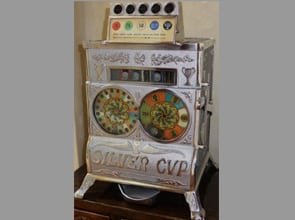
By Rick Crandall © 1915
THE COIN-OP GAMBLING-MACHINE INDUSTRY got started by an 1891 Sittman and Pitt invention in Brooklyn, NY which was a gaming machine based on Poker. It contained five drums with 50 cards and it rode the wave of popularity of Poker, especially in New York. It is often described as the precursor to the modern slot machine. However, these machines had no direct-payout mechanism, so establishments would offer a patron a free beer or cigar for a winning hand which would be defined by the proprietor and changed from time-to-time. It was a trade stimulator.
Charles Fey
Then a few years later in 1895, in San Francisco, Charles Fey invented what today we would call the “game changer.” Fey solved the problem of making an automatic pay-out game-of-chance. As the story goes, Fey was watching a Ferris wheel at a carnival and it gave him the idea of making a machine with reels. He found that a mechanism computing payouts based on a Poker hand and five reels would be too complicated. He felt that three reels gave the ideal percentage combination, so the 3-reeler was born.
This was the Liberty Bell that is undisputedly the genesis of the massive gaming-machine industry that still sports electronic versions of spinning reels today.
Charles Fey never did believe in patents. His strategy was to be always a jump ahead of the field rather than relying on patent protection. Even if he had patents, California’s anti-gambling laws would have made enforcement a problem. His experience with that arose when a former acquaintance, Gustav Schultze, was awarded a patent in 1893 for his Horseshoe slot machine which he then attempted to use aggressively against others including Fey in an 1897 patent-infringement lawsuit. In the end the court ruled against Schultz by arguing that his patented slot machines had gambling as their purpose which is illegal and thus unworthy of protection!
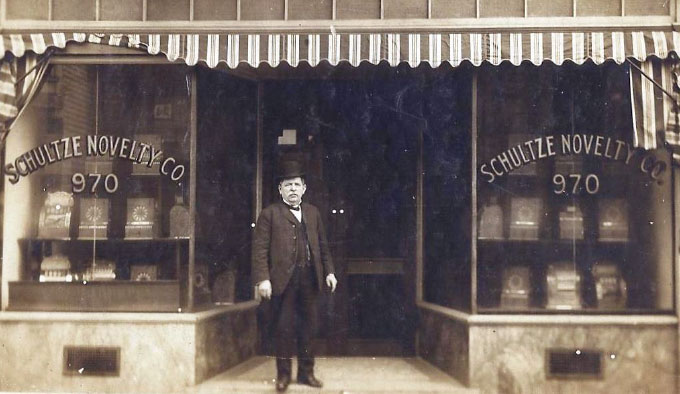
Gustave Schultz at his storefront featuring his early machines.
Photo courtesy of Roger Kislingbury from his American Saloons, Pre-Prohibition Photographs
See: http://historicalsaloonphotographs.com
According to Fey’s son, Edmund, a San-Francisco saloon was burglarized one night in 1905 and just two items were taken, a bartender’s apron and a Liberty Bell. Two years later a copy of the Liberty Bell, including using the name, appeared in Chicago, manufactured and sold by the Mills Novelty Company, and the copying didn’t stop with Mills.
Another theory is that it wasn’t about a theft, rather that Fey actually went into business with the Mills Novelty Company to achieve a jump on the field using Mills’ high-volume assembly-line manufacturing. Whichever is right, copying the Liberty Bell became a clarion call for several manufacturers, and the 3-reel “one arm bandit” quickly became commoditized.
This was occurring in the period 1907 – 1910. One can imagine that once seeing the 3-reel Liberty Bell and follow-on Operator Bell becoming so prevalent, that Charles Fey, “the Edison of slot machines,” (1) would kick into action and create a new design.
(1) As proclaimed by his peers at the 1937 convention of the National Association of Coin-Op Machine Mfrs.
Fey Silver Cup
So what did he do? Well, according to Fey himself, “Take a coin chute for the people to put their money in, and a cash box for the money to go into and put something in-between that will interest the people, and you’ve invented a new slot machine.”
And that’s just what he did – a machine with two dials instead of 3-reels! He made them color wheels spinning in opposite directions to create a sense of anticipation and interest. Furthermore he really mixed it up – he put the five-coin head, only found on big floor-model slot machines, onto a compact table-model machine. The Silver Cup was born.
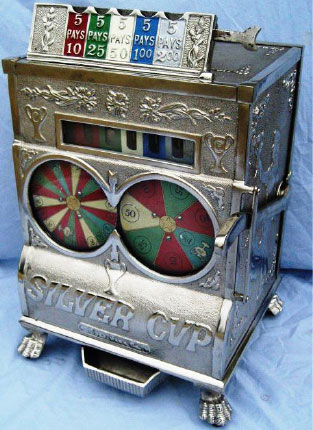
Fey Silver Cup
Caille Brothers, Co. Follows Fey with its Own Silver Cup
By 1910 or so, the Fey Silver Cup must have caught the attention of the Caille brothers. By 1911 they had developed an attractive and nearly identical-looking version of the Silver Cup with decorative dial graphics and using similar principles of operation. Some current-day collectors think of Caille as a copy-cat manufacturer, albeit with a great sense of engineering quality and esthetic-design attractiveness. Caille had indeed followed Fey not only with the Silver Cup but also earlier with its version of a Liberty Bell 3-reeler, among some others.
However, research into the two brothers and the Caille company paints a different picture – one of innovation, cosmetic-design excellence, mechanical ingenuity and patents. First let’s take a look at the Cailles as individuals and then the company they founded and ran to great success.
The Caille Brothers
Excerpted from: The Book of Detroiters Edited by Albert Nelson Marquis 1908
Adolph A. Caille is the elder brother. He was born in Detroit on April 2, 1863. His father, Joseph Caille, was an immigrant from one of the French-speaking cantons of Switzerland. Joseph was a cabinetmaker by trade in Switzerland. He immigrated to the U.S. and settled in Detroit in 1831. There he re-established himself initially as a furniture and cabinet-maker and eventually as a retail furniture-store owner. Adolph was educated to the public-school level in Detroit. As a youth he learned the wood-working trade under the direction of his father and began with making furniture. He became a skilled mechanic and woodworker. His role in Caille Brothers Co. was as vice president, co-owner and general supervisor of the manufacturing department.
Auguste Arthur Caille, was born on April 1, 1867 in Detroit. When A. Arthur was ten, the family moved from Detroit to Saginaw, Michigan. There he completed his education in public school. In 1883, he apprenticed as a woodworker under the tutelage of his father. He too became a skilled and inventive mechanic. His first invention was a cash-carrier system, which he patented, for use in mercantile establishments. His role in Caille Brothers Co. was as President, co-owner and Treasurer.
A third sibling, sister Louise Caille, was married to Robert Yates, an operator of Caille machines.
Caille Brothers Company
Excerpted from History and Biography, the City of Detroit and Wayne County by Henry Taylor Co., Chicago, 1909:
The Caille Brothers Company is one of the most notable industrial enterprises of Detroit which has given the city a place among the leading manufacturing centers of the world [remember this is largely before the development of the auto industry]. The Company is one of the largest manufacturers of coin-slot apparatus in the world employing 500 mechanics at its apex.
The Caille Brothers Company was incorporated in Michigan in 1901 with a capital stock of $300,000. Coin-controlling machines of fully 80 different types are manufactured (in 1909). The annual output of the plant has now reached the enormous average of 12,000 machines, all of which are fully protected by patents issued to the Caille brothers. [Well, they did successfully patent some of their devices, but this statement is an exaggeration since many payout games-of-chance were not patentable and some were copied from Fey designs]
Caille Patent for a Game of Chance?
Caille actually had a patent for a game of chance way back in 1901, but with no automatic payout. Apropos of the Silver Cup – it did have a right-side lever and a dial but this device worked differently. Instead of selecting a color by dropping a coin in a coin-head, you pushed on one of the 4 buttons on top – then you pushed down on the lever handle, the dial spun and if it landed on your selection a tab would pop up in the window on top (like a cash register) indicating your winnings. Presumably you would collect whatever you won from the proprietor. No known examples of this device exist to my knowledge.
![]()
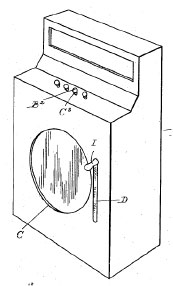
Game of Chance #741,528: A machine for playing games of chance having a member in the form of a wheel or disk, a plurality of projectable tablets and a series of tablet-selecting devices so that upon the selection of one of the tablets and the rotating of the wheel the selected tablet may or may not be projected according to the position the wheel assumes when brought to rest.
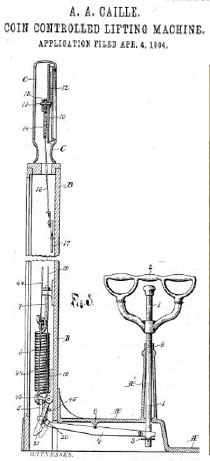

Lifting Mechanism 1903 (Caille Samson)
Improvements in coin-controlled lifting machines, to provide a simple, cheap and efficient construction which is not liable to get out of order or be broken
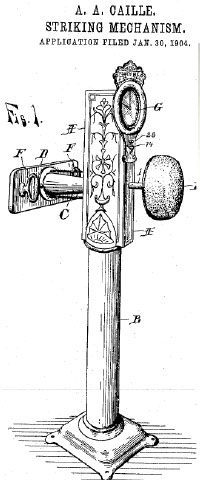
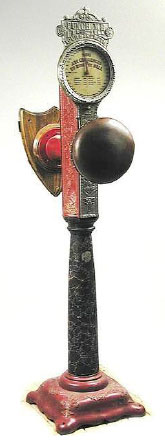
Striking Mechanism 1903
For testing the strength of a person in delivering a blow with the fist; to provide a strong, simple, cheap and compact device indicating the force of the blow; also that the shock of the blow will not be transmitted to the indicating means … and to provide means for controlling the operating by a coin.
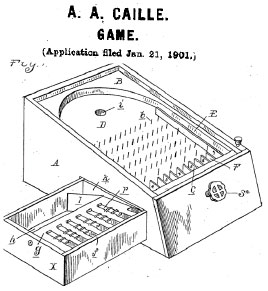
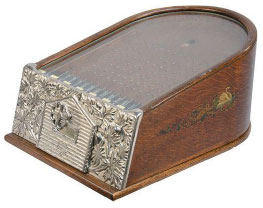
Caille Log Cabin – 1901. Game of chance in which marbles or balls are shot upon an inclined board having a series of obstructions thereon and a series of pockets at its lower edge, the object being to lodge said balls in certain of the pockets. Further to provide means for registering the count of the successive plays so that at the end of the game the complete tally thereof is obtained
A.A. Caille Patents:
| 850,817 Coin Controlled Machine Sept 11, 1905 793,677 Striking Mechanism filed Jan 30, 1904 792,694 Coin-Controlled Weighing Machine Oct 29, 1903 783,678 Coin Controlled Lifting Machine filed Apr 4, 1904 |
783,993 Weight Verifier May 4, 1903 730,232 Vending Machine Nov. 1, 1902 711,383 Game filed Jan 21, 1901 |
The Caille Silver Cup
The first version of the Caille Silver Cup was similar-looking to the Fey machine although it had some differences. Cosmetically the dials are much fancier and the feet are a bit simpler – the Fey machine used the claw feet from the Liberty Bell. Functionally there are some differences, Caille designed its own mechanism and a somewhat different coin head, although still supporting playing up to five coins on an arm-pull – either from multiple players or multiple bets from one player. Caille catalog descriptions claim some differentiating features that would strike an attractive note with operators:
- Checks are slightly larger than a nickel; checks go to cut-out, nickels go to cash box.
- If a bent coin is forced into the machine, the pay-out is locked and won’t accidentally give out rewards
- Coin-detector window shows last coin played
- Clock-work governor is used exclusively on the Silver Cup
- Automatically kicks out pennies from the coin chute and deposits them in a penny compartment.

Fey and Caille Trade tokens.
Indeed larger than a nickel
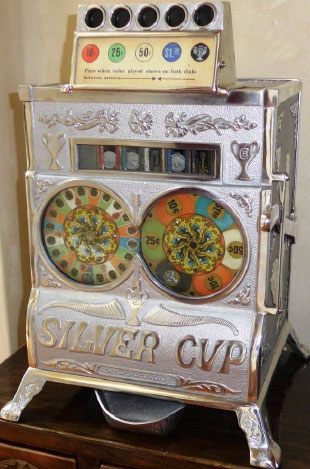
Caille Silver Cup – earliest known model serial # 35
circa 1911-1912. Rick Crandall collection
The banner below the “Silver Cup” is pebbled on earlier machines; later machines after 1916 have the words “Caille-Detroit” in the banner.
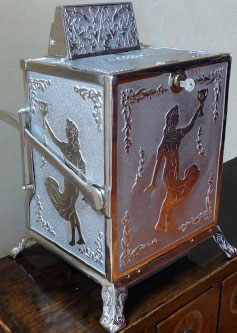
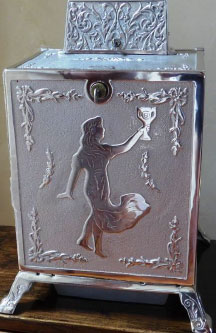
The action of the machine is interesting – The player selects one or more of any of the five color options of red, green, white, blue or black (with silver cup icon) which pays 10¢, 25¢, 50¢, $1.00 and $2.00 respectively. Crank the handle and both wheels spin. The right wheel has 7 stopping positions representing at least one of the five playable options on the left wheel has 20 stopping positions, also representing at least one of the 5 playable options. A winner is paid in checks or nickels if the color of the right wheel matches any of the two colors on the left-hand wheel when they stop if that color had been bet.
From Johnny Duckworth:
“I have observed two different mechanisms Caille produced for the silver cup. The first model had individual slides across the front of the mechanisms, whereas the second model had only one set of slides with two pay tubes to make all the payouts. This payout system also resembles the same one later used on the Caille Aristocrat. Somewhere after serial #340 this machine must have been a little loose on the 25¢ green payout as it was changed to 20¢ where it remained until the end of production. Another interesting change was the pay cup which started out in the center only to be moved to the right side sometime after serial #640 but then to return sometime after #881. This move to the side may have been a bad decision at the factory since the coins had to make a hard right turn out of the pay slides to enter into the pay cup below. I even had one collector who has the version with the pay cup on the right tell me he has had the coins jam up in that area before. They were only produced in a nickel-play version and the machines I have been able to track down bear the serial numbers 35, 129, 340, 523, 593, 614, 639, 640, 642, 690, 712, 746, 752, 880, 881 & 4892. The 4892 is a real number – a mysterious Caille skip in numbering with no clue what it signifies.
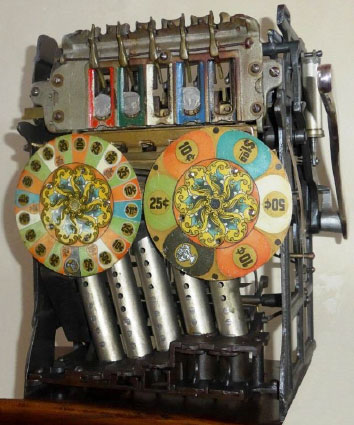
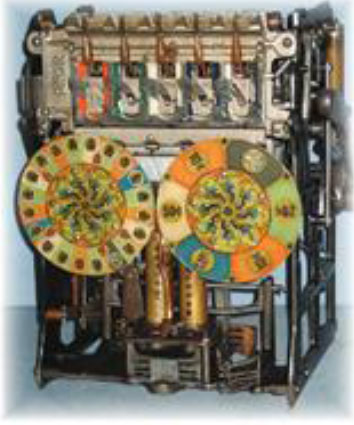
Caille Silver Cup #35 earlier mech on left with 5 payout tubes and 25¢ payout on green; later mech (right) pays out all combinations from two tubes with stingier 20¢ payout on green.
Caille Catalog Pages
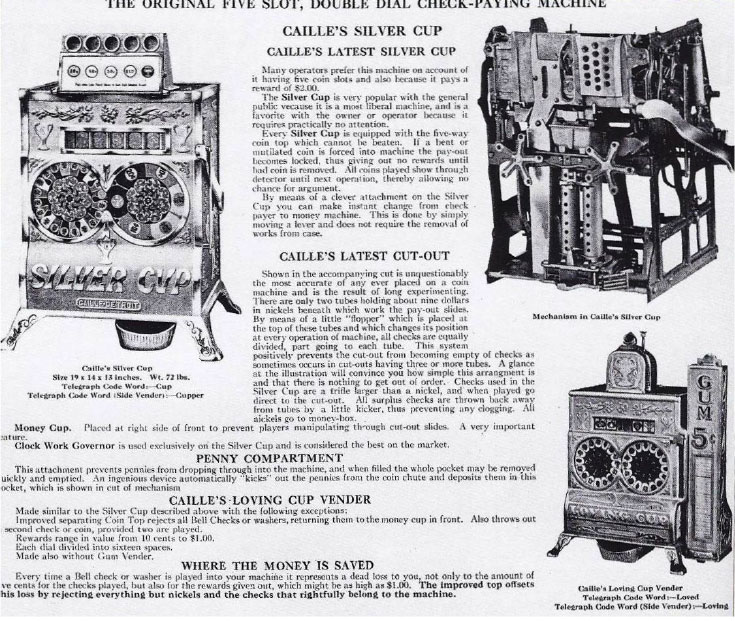
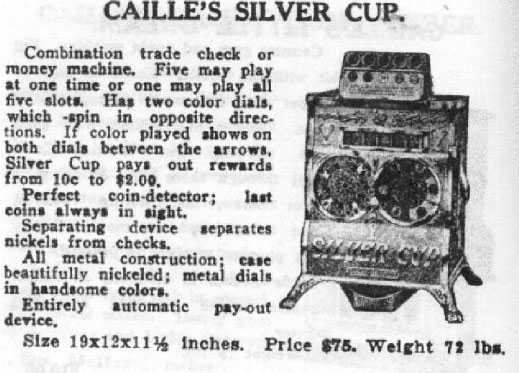
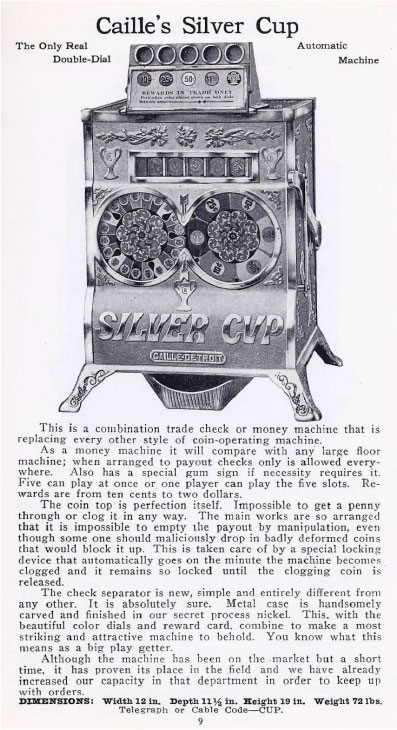
Early and Later Caille Silver Cup Mechanism Pictures
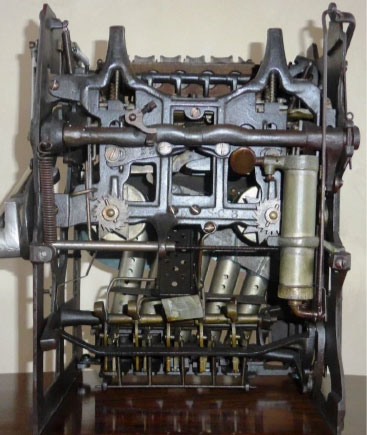
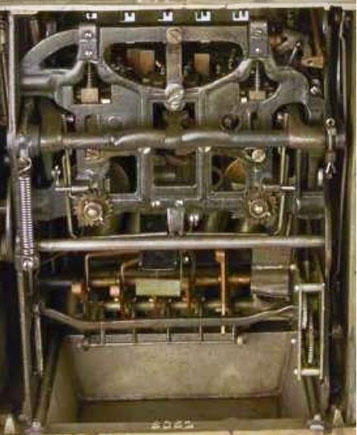
Early style serial #35 rear mechanism (above) Rear mechanism later style serial #881
Note: above the earlier mechanism has the pump-type governor (vertical cylinder on the right of the mech) and the later mechanism uses the clock-work governor which is specifically mentioned in the catalog page.
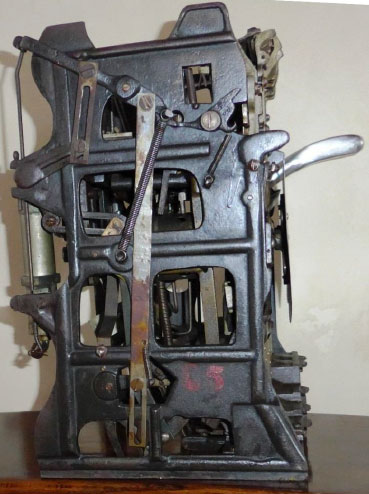
Serial #35 Silver Cup mechanism left side view.


